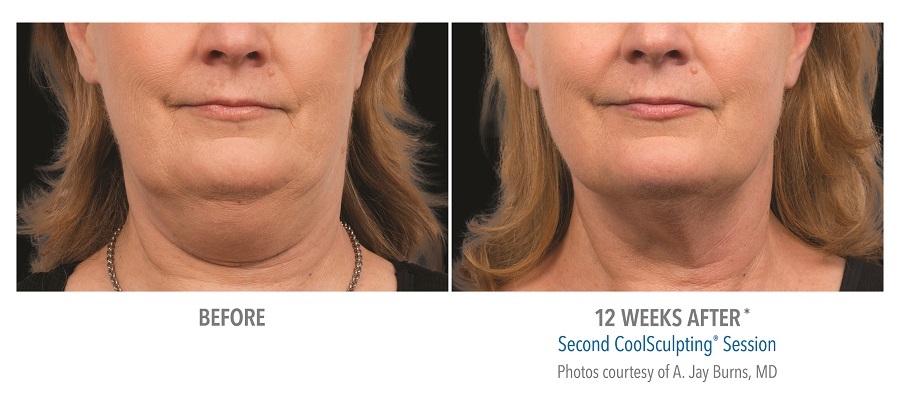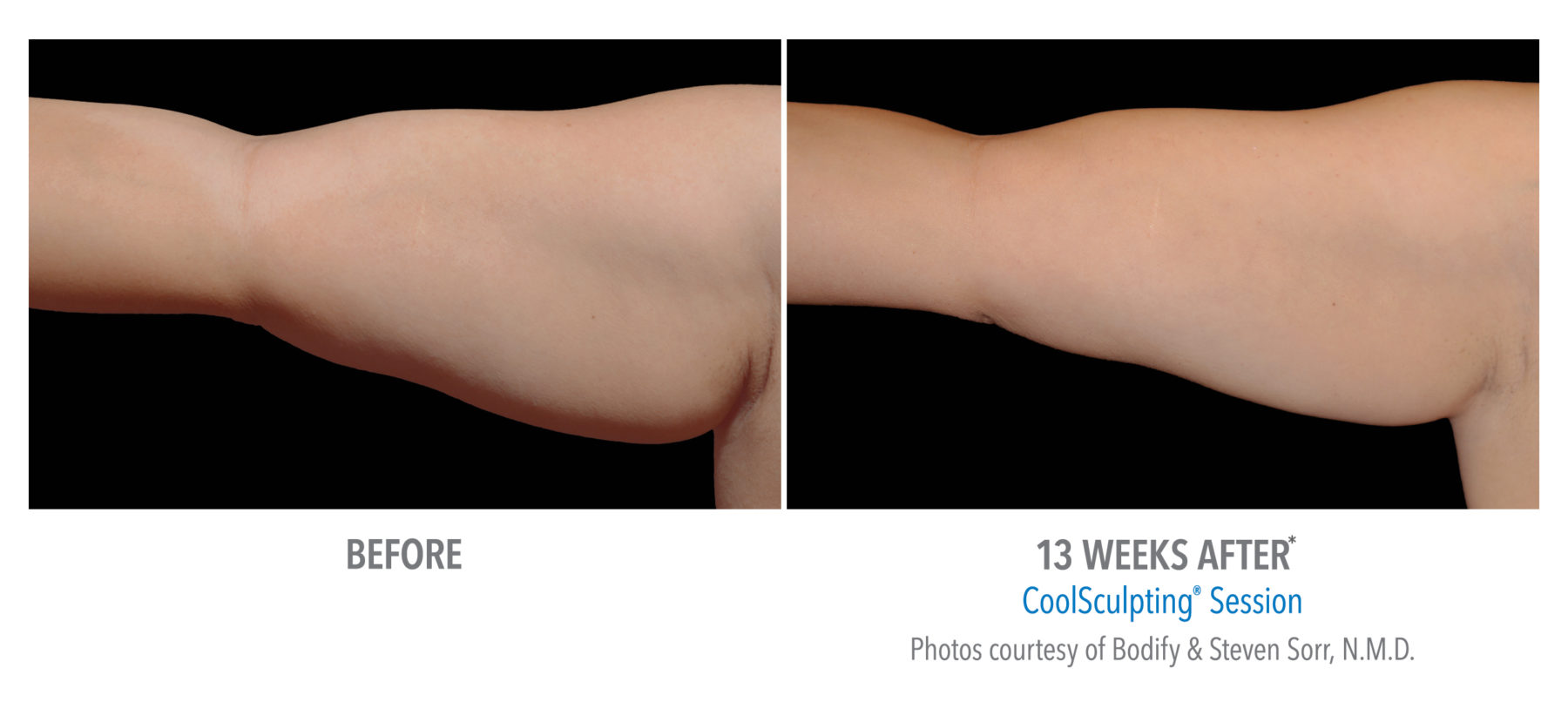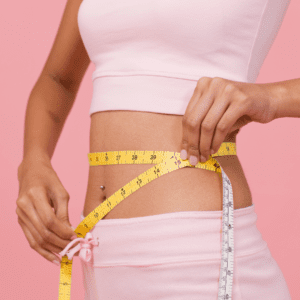Despite a clean diet and regular workouts, many women and men experience unwanted fat that prevents them from looking and feeling their best.
If you are struggling with stubborn bulges on your abdomen, hips, thighs, arms, back, chest, or chin, CoolSculpting may be able to offer a safe, effective, and non-surgical solution.
Since earning FDA-clearance in 2010, CoolSculpting has become one of the most popular non-invasive body contouring treatments. It even has a number of celebrity fans, including Molly Sims and Kristin Davis, who’ve readily shared their positive experiences and remarkable results.
So, is CoolSculpting right for you?
Continue reading for everything you need to know about CoolSculpting and what you can expect should you decide to undergo this fat-freezing treatment.
Here’s our definitive guide to CoolSculpting for 2020.
What Is CoolSculpting?
CoolSculpting is a non-invasive fat removal treatment invented by two Harvard physicians, who observed that children would develop dimples after eating popsicles.
They discovered that the popsicle’s cold temperature destroyed localized fat cells, a phenomenon known as popsicle panniculitis, and believed that this process could be applied to other parts of the body with unwanted fat. Thus, CoolSculpting was born.
The procedure is ideal for small areas of stubborn subcutaneous fat and is performed in the comfort of your doctor’s office, without incisions, anesthesia, or downtime.
During each session, applicators of different shapes and sizes are fitted to the treatment area and deliver a controlled cooling effect, with temperatures as low as negative 13 degrees Celsius. As a result, fat cells freeze, crystallize, and die. They are then naturally eliminated from the body by the lymphatic system.
While removal occurs gradually over several weeks to months, it is permanent, and destroyed fat cells are gone for good.
CoolSculpting Treatment Areas
CoolSculpting first gained FDA-clearance in 2010 for fat reduction in the flanks a.k.a. love handles. Since then, the non-surgical procedure has been cleared for treatment in a number of areas of the body and face.
These include:
- Upper abdomen
- Lower abdomen
- Flanks
- Hips
- Outer thigh
- Inner thigh
- Upper Arms
- Bra line
- Double chin
- Fat under buttocks (“banana roll”)
Although excess male breast tissue (gynecomastia) is not an FDA-cleared area, we can still effectively treat this for patients.
Am I a Good Candidate for CoolSculpting?
For the right candidate, CoolSculpting can achieve circumferential reduction and body contouring that helps women and men look and feel better in and out of clothes.
That being said, CoolSculpting is not for everyone and is best-suited for healthy adults that are within 20-30 pounds of their ideal weight and have stubborn fat pockets that have not responded to diet and exercise.
Additionally, unwanted fat should be pinchable with well-defined borders and a distinct peak in the abdomen and outer thigh area. This helps ensure a proper fit with CoolSculpting applicators.
It’s also important that CoolSculpting candidates have good skin elasticity. Patients with loose skin are still treatable–expectations just have to managed.
Contraindications for this procedure can include, but are not limited to:
- Cryoglobulinemia
- Paroxysmal Cold Hemoglobinuria
- Cold Agglutinin Disease
Is CoolSculpting Safe?
CoolSculpting is extremely safe, especially in comparison to surgical fat removal, and doesn’t require incisions, anesthesia, or recovery.
What’s more CoolSculpting is well-tolerated by most patients, who find the treatment to be virtually pain-free.
However, mild and temporary side effects following CoolSculpting can include numbness, bruising, and soreness, which typically resolve on their own in several days.
How Should I Prepare for My CoolSculpting Treatment?
CoolSculpting is a non-invasive, quick, and zero-downtime treatment that requires little to no preparation. Nevertheless, to ensure a seamless and smooth procedure, here are several steps to take before undergoing CoolSculpting:
- Schedule an in-person consultation and learn if CoolSculpting is right for you
- Receive a customized treatment plan, including the number of treatment sites you would like to address
- Avoid anti-inflammatory medication, such as Advil and ibuprofen, one-to-two weeks prior to treatment to help reduce likelihood of bruising
- Wear comfortable, loose-fitting clothing on the day of your procedure
- Bring entertainment, including books, tablets, and music, to help pass time during the treatment
What to Expect from a CoolSculpting Procedure?
On the day of your CoolSculpting procedure, you will arrive to the office and complete any necessary paperwork, including an informed-consent.
Next, you will be shown to your treatment room to change and will have the opportunity to discuss any questions or concerns you may have.
Then, measurements and photographs will be taken at different angles, and skin will be marked to outline proper placement of the device applicator.
The last stage of CoolSculpting prep includes placing a gel-pad over the treatment area, which serves as a barrier between your skin and the device.
Finally, the provider activates the applicator, which suctions targeted tissue, and then secures it to the patient with the help of a pillow or strap.
Once the CoolSculpting process begins, the applicator’s cooling panels freeze fat cells, without harming skin or surrounding structures.
It may take about five minutes for patients to ease into the treatment, but most individuals say that they are able to comfortably recline and relax for its duration.
Upon completion of the treatment site, the applicator is removed. Tissue will feel very cold to the touch. Lastly, the area is manually massaged for approximately two minutes which can increase efficacy by 68 percent.
What Is the Treatment Time for CoolSculpting?
Each CoolSculpting session takes between 35-75 minutes, depending on the body part and applicator being used. If you are treating multiple areas, your entire procedure can take several hours.
In 2016, CoolSculpting introduced its CoolAdvantage applicator, which operates at a lower temperature, offers increased contact with tissue, and reduces treatment time to 35 minutes per application site.
This three-in-one applicator adjusts to three different sizes to fit each patient’s size and shape:
- CoolFit Advantage for vertical areas like inner thighs
- CoolCore Advantage for contours of the abdomen
- CoolCurve+ Advantage for flanks
Additionally, the CoolAdvantage Plus applicator is ideal for larger areas on the abdomen and flanks, while the CoolAdvantage Petite applicator can treat the upper arms.
CoolAdvantage can also be used on the upper arms in addition to CoolAdvantage Petite.
Another way to reduce treatment time is with DualSculpting, which utilizes two CoolSculpting systems to treat areas simultaneously.
What Can I Expect from CoolSculpting Recovery?
One of the key benefits of CoolSculpting is that it doesn’t require any downtime. This means that patients are free to return to work and resume all normal activities immediately after their procedure. They can even engage in exercise or physical activity that same day if they are feeling up to it.
At most, patients may experience some mild pain, tenderness, swelling, numbness, or bruising following CoolSculpting. These effects subside in a matter of days and can be effectively managed with over-the-counter pain relievers.
How Soon Can I See CoolSculpting Results?
Within four-to-six weeks, patients can begin to see a visible slimming and contouring of the treatment area. CoolSculpting results peak around 12 weeks, producing an average 20-25 percent fat reduction and a leaner, more sculpted physique
For optimal outcomes, a series of one-to-two sessions, spaced four-to-12 weeks apart, is recommended.
Are There Any Risks or Side Effects of CoolSculpting?
As previously mentioned, CoolSculpting is a very safe and effective procedure. Side-effects are usually mild and temporary, without any impact on the patient’s daily routine, and can include:
- Redness
- Firmness
- Swelling or bloating
- Localized numbness
- Mild bruising
- Whitening of the skin around the treatment area
- Mild to moderate pain or cramping
- Tenderness at the treatment site
- Itching or tingling sensations
More serious complications are extremely rare (less than one percent of patients) and can be discussed in greater detail with your physician.
How Does CoolSculpting Compare to Other Body Contouring Treatments?
CoolSculpting vs. Liposuction
Liposuction is a surgical procedure used to remove large volumes of fat from various parts of the body. It’s associated with increased risk and pain and requires incisions, general anesthesia, and a potentially lengthy recovery.
Comparatively, CoolSculpting is completely non-invasive, non-surgical, without the need for cutting, anesthesia, or any downtime. Plus, CoolSculpting is virtually painless and allows patients to recline, relax, and watch tv or read for the duration of their treatment.
That being said, CoolSculpting is ideal for women and men with localized fat, that’s resistant to diet and exercise, while liposuction may be a better option for individuals with a substantial amount of unwanted fat, who are looking for dramatic results.
CoolSculpting vs. Laser Lipolysis
Laser lipolysis is a minimally-invasive surgical procedure that heats and destroys targeted adipose tissue. It’s performed under local anesthesia and involves inserting a laser fiber under the skin to melt fat cells, which are then aspirated with a cannula or metabolized by the body.
While laser lipo has the advantage of tightening skin in the treatment area, laser lipo requires a longer recovery and has greater risks, including possible damage to blood vessels, nerves, and internal structures.
CoolSculpting vs. Velashape
Velashape is a non-surgical treatment that delivers radiofrequency, laser energy, and deep-tissue massage to areas of unwanted fat. The latter allows Velashape to reduce cellulite and firm skin, in a way that CoolSculpting cannot.
These effects can sometimes be noted after the first treatment, but it can take three-to-six sessions to achieve optimal outcomes.
However, compared to CoolSculpting, Velashape tends to be less efficient and less predictable. It also requires ongoing icing during the treatment and poses a possible risk of burns.
CoolSculpting vs. Zerona
Zerona is another non-invasive body contouring procedure that employs laser energy to liquefy and shrink fat cells and tighten skin.
Patients considering Zerona should be prepared to undergo a 40-minute treatment, every other day, for 15 days. Missing one of these sessions could interfere with results.
It’s also important to note that while CoolSculpting permanently destroys fat cells, Zerona may only be able to shrink them. Consequently, Zerona effects have the potential to be temporary.
CoolSculpting vs. SculpSure
SculpSure is a non-invasive fat reduction treatment indicated for the love handles, abdomen, thighs, back, and double chin. In a 25-minute treatment, it delivers concentrated laser energy to melt fat cells and tighten skin, without burning or bruising.
Nevertheless, CoolSculpting has been FDA-cleared and in-use for longer than SculpSure.
As a result, many plastic surgeons and dermatologists trust and prefer CoolSculpting for its proven track record of safety and efficacy.
CoolSculpting vs. truSculpt
Another body contouring treatment that had a short-lived popularity is truSculpt. This procedure is a radiofrequency body contouring treatment that offers fat reduction, cellulite reduction and skin tightening.
The marketing push behind truSculpt states that the treatment is performed with a small hand-held device that is ideal for flat areas that CoolSculpting cannot adequately suction, though the results have been less than stellar when compared to CoolSculpting.
It is also appealing to women seeking a non-invasive approach to address loose skin and unwanted belly fat post-pregnancy.
CoolSculpting vs. Liposonix
Using ultra-high frequency ultrasound, Liposonix destroys fat cells, stimulates collagen, and tightens skin in the abdomen. It’s indicated for use on areas of pinchable fat that are less than one inch, and the procedure requires prescription pain medication.
Accordingly, Liposonix is less comfortable and versatile than CoolSculpting, as it can only be used for very small areas of abdominal fat.
How Much Does CoolSculpting Cost?
The cost for CoolSculpting can vary depending on the treatment area and number of cycles performed. Prior to undergoing CoolSculpting, you will receive a customized treatment plan that outlines the number of recommended applications to each area, so that you can anticipate the final price of your procedure.
While the national average for a CoolSculpting treatment is $600, geographic location and provider expertise are two important factors that can affect cost.
If you are considering CoolSculpting in Northern Virginia, please contact CoolContours today to schedule a comprehensive CoolSculpting consultation with one of our highly-skilled and experienced providers.
Schedule a CoolSculpting Consultation Today!
[gravityform id=”1″ title=”false” description=”false” ajax=”true”]







